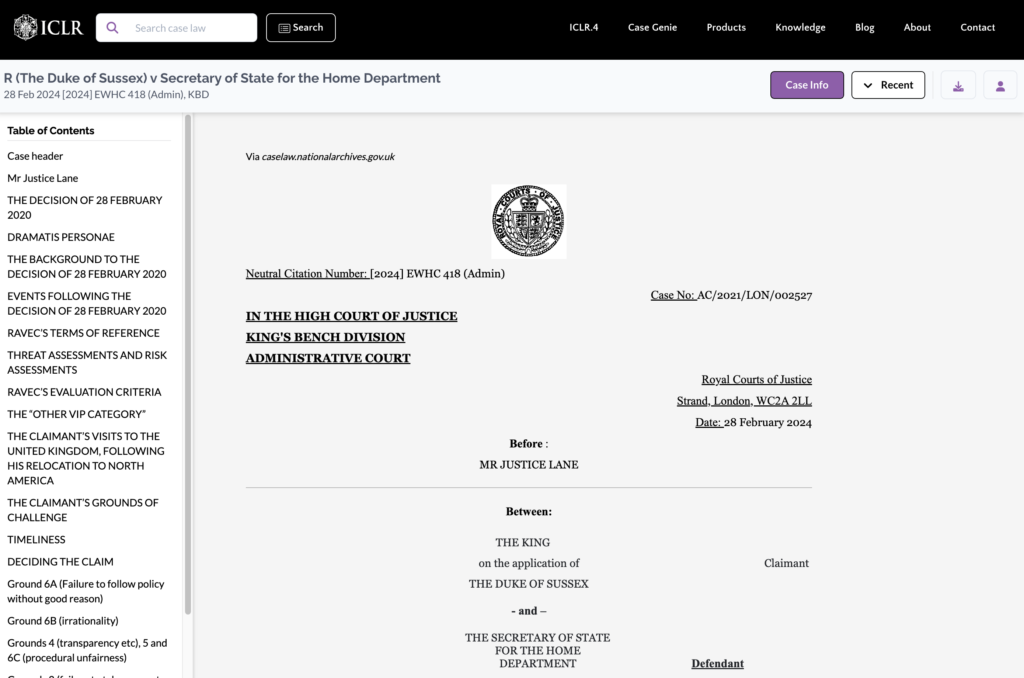
The idea that the law should be freely accessible to all the people is nothing new, but it is technology that has enabled that aspiration to be realised. ICLR has taken advantage of that to provide, alongside its reported case law subscription service, a freely accessible version of both unreported judgments and legislation. Recent developments have enabled that provision to be more complete and convenient than ever before.
Access to law
“The law” includes, as primary sources, both legislation and case law. Whether the law is accessible in the sense of being intelligible is a matter for the law makers, who include statutory drafters in Parliament and the judiciary in the senior courts. Whether the law is accessible in the sense of being easily found depends on how and where it is published.
In the days when everything was printed, legislation was published by The Stationery Office (TSO), and case law was available mainly through the publication of law reports, by ICLR and other legal publishers. Case summaries might also appear in legal journals or newspapers. But it all cost money.
The launch of BAILII (the British and Irish Legal Information Institute) in 2000 was a game changer. Taking advantage of cheap publication via the internet, BAILII gave effect to the aims of the Free Access to Law Movement (FALM), under whose mission it had been founded as a legal charity, funded by donations. BAILII published freely accessible digital versions of senior court judgments. The development coincided with the introduction of numbered paragraphs and neutral citations, designed to facilitate the citation of digitised judgments without the need for printed page publication references. It also began to collect and publish primary and secondary legislation in its original (ie unamended) version.
In 2003, BAILII entered into an agreement with the Ministry of Justice to publish judgments of the High Court and Court of Appeal of England and Wales. That meant that it became an official repository and, theoretically, distribution point for new judgments. BAILII also published judgments from other courts and tribunals, and from other jurisdictions. Where no neutral citation had been assigned, it simply made up its own.
ICLR was able to index judgments on BAILII, but users had to follow a link to BAILII to read the content. BAILII in turn added links to ICLR where cases had been reported. While BAILII allowed users to download individual judgments, and to index new content via its RSS feeds, its terms of use prohibited the routine or wholesale reuse of its content.
Distribution for re-use
All that changed in April 2022 when, at the behest of the MOJ, who had terminated its contract with BAILII, a new case law service was launched by The National Archives (TNA), called Find Case Law. TNA had previously taken over and brought up to date what used to be called the Statute Law Database (now legislation.gov.uk), so it was well suited to the task, though the two databases remain separate.
Find Case Law made a virtue of the fact that it had been designed from the start as a distribution hub, and not merely a repository, of new case law. Subject to the terms of its Open Justice Licence, and using its designated Atom feeds, third parties such as reporters and legal publishers are allowed to download and reuse all its judgments in a wholesale fashion.
Under a separate Computational Licence, researchers and developers are also able to conduct bulk data analysis on the content and use it as training data for machine learning. ICLR has taken advantage of this to make major changes to the range of content it provides.
One of TNA’s core functions is to:
“promote the re-use of public sector information and regulate the information-trading activities of organisations that create and collect public sector information.”
ICLR is a typical re-user of public sector information. We re-use it in two ways. We publish it, in its original form, as a free service on our database. And for those cases that merit preservation, study and citation as legal precedents, we incorporate the judgment into a full text law report. That involves adding a headnote, summarising the important legal issues in the case and its ratio decidendi, as well as index catchwords, lists of cases cited and a summary of the procedural history. Proofs are sent to judges for approval before publication.
The reports might require a subscription, but the underlying judgments and related index information remain freely available on our website.
Marked up text
The judgments are available in XML which has been tagged using Legal Document Markup Language (LegalDocML) to provide consistently structured information across all the judgments and decisions. This makes it possible not only to display the content on our platform in HTML in a standardised layout, but also to identify elements such as titles and headings within the judgment, and to extract a Table of Contents to help the reader navigate around the document. This is particularly useful for long judgments, which can pose a challenge to read online.
The intention is for all judgments to be written using a standard template. But many judges are continuing to use old or unsuitable templates, and TNA are not always able to correct the inconsistencies when converting and marking up documents from Word, say, into XML. So while some of the published judgments are extremely well formatted, making it easy to extract and display a TOC, others are not. This can result in some headings being missed from the TOC, or being assigned the wrong heading level.
Judgments are distributed via an Atom feed, which re-users can poll regularly. Provided courts deliver judgments promptly to TNA, they can be released within hours of delivery. Many are not even handed down in court any more, but simply emailed to the parties and sent to TNA for publication.
ICLR publishes the judgment as soon as it receives it via the feed. It then undergoes a series of processes to enrich the content, identifying and tagging any cases mentioned in the text, and adding links to those cases on our platform. A full list of the cases cited is then added to the Case Info page for the new judgment, and corresponding links added to the Case Info pages of any indexed cases, identifying those other cases as having been cited in this one.
Links are also provided from the text of the new judgment to any UK or EU legislation mentioned in it, derived either from legislation.gov.uk for UK legislation, or EUR-Lex for EU legislation. The link for UK legislation opens the relevant statute or statutory instrument on the ICLR site, but the content is derived from legislation.gov.uk via its API. The link for EU legislation goes directly to the relevant page on EUR-Lex. It is usually possible for the user then to select whichever point in time version is appropriate.

Additional content
ICLR has also added unreported judgments from other sources, including all the English language judgments dating back to the 1950s from the European Court of Justice, via the Curia database, and is in the process of adding judgments from tribunals such as the Competition Appeal Tribunal, and ecclesiastical cases from the Consistory Court, whose content is not currently included in Find Case Law. These have also been enriched to extract lists of cases, even if the text (sometimes only available in PDF form) cannot be enriched to add links directly. This is something we are still working on.
A further stage of enrichment comes when human reporters review the new judgments, to assess their “reportability” according to long-established criteria, and in any event to classify them by legal topic and subject matter, using standard index headings. Even if the case is not reportable, this additional index information assists the user to sift through search results derived from either a conventional search or one using our AI-driven recommendation engine, Case Genie.
Further developments are currently underway. We’ll be writing about those later in the year.
Paul Magrath is Head of Product Development and Online Content at the Incorporated Council of Law Reporting for England and Wales. He is also the co-author of Transparency in the Family Courts (2nd ed, Bloomsbury Professional, 2024).